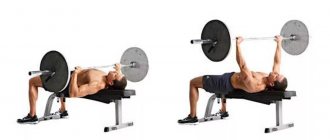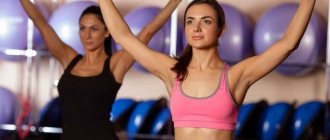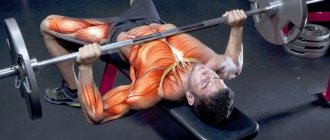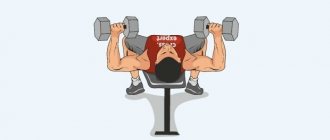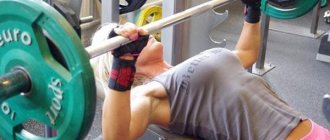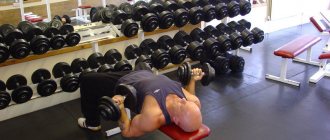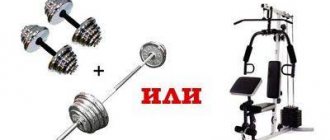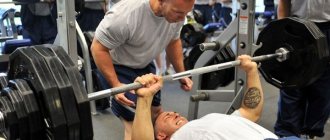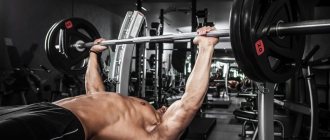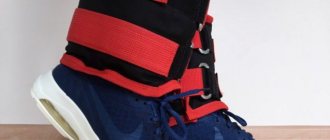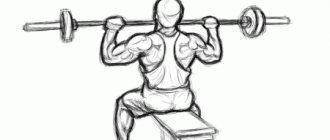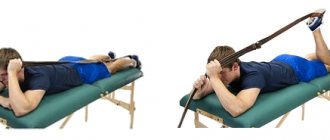The bench press is a basic multi-joint exercise that involves a large number of different muscle groups; therefore, depending on the technique of performing the press, you can use one or another muscle mass to a greater or lesser extent. The bench press is also a competitive movement in powerlifting; moreover, the bench press is an independent sports discipline, and there is no such variability in technique in any other exercise. The bench press can be performed with different positions of the arms, legs, and body; in general, the bench press involves so many different execution options that it is difficult to call them all the same exercise. But when we talk about replacing this exercise, we usually mean a chest press, so this article will discuss exactly why and why it is necessary to replace such a press.
However, before we talk about what can actually replace the bench press, we should mention such a thing as macro cycles and the difference in tasks during the strength and mass-gaining periods. The annual training plan of any athlete is divided into three periods: a period of working on strength indicators, a period of gaining mass and a period of working on quality. We have already written in some detail about various theories of muscle growth , so if you want to better understand the reasons why you should do it this way and not otherwise, you can familiarize yourself with this theoretical calculation. If you are an avid practitioner, then it is important for you to understand that during the strength period the emphasis is on developing the speed-strength qualities of the muscles in the repetition range from 2 to 6 in heavy basic exercises, and during the “mass gain” the athlete pumps up the muscles, realizing the accumulated strength potential and allowing the body to build up protein structures. This is what we need to proceed from, since the goal determines the means, not the means, the goal!
Changing the French press to parallel bars
The first thing that comes to my mind that has a comparable effect for the development and formation of triceps muscle mass is working on the uneven bars. In fact, we are talking about a multi-joint exercise that involves the elbow and shoulder joints, so the load can go on both the chest muscles and deltoids.
Read also: Why iodine is applied with a mesh
How to properly replace the French press so that only the triceps function?
- The first secret is the maximum vertical position of the body. When bending forward, the chest muscles will begin to work. Your head and your gaze directed upward can help you a little in this task.
- The second secret is full extension of the arms at the elbows at the top point.
- Secret number three is a narrow grip. If you can find V-shaped bars in your hall or yard, then this is the best option.
Alternatives
Similar in action is simple twisting on a bench while lying down, and exercises on the floor.
Some people manage to do straight crunches in a hyperextension machine, but this is quite inconvenient. This exercise can also be replaced with crunches in a seated abs machine. If you concentrate on the movement, the effect will be about the same as that of a simple twist.
It’s important to work on your abs during training, but for their definition, it’s also important to organize a balanced diet, not overeat, and burn excess fat. https://www.youtube.com/embed/CD78fMVLTuo
Equipment for performing the French press
In gyms, several types of equipment are used to perform exercises. Three main types:
- dumbbells;
- barbell;
- block simulator.
Pumping up the triceps with the French press is traditionally done using dumbbells or a barbell . To perform certain types of training in question, a bench is additionally used to sit or lie down. However, many people prefer to do this exercise while standing. Each method has won its fans, so it’s difficult to say which method is better.
Often in gyms you can find special block exercise machines for pumping selected areas. They attract attention because the trainee feels the muscle better. This is a safer method than working with free weights directly. Despite all the advantages, many professionals believe that this method is less effective than the classic one.
How to do it right
It should be noted that more than half of those people who come to the gym have a rather poor understanding of how to properly perform a bench press using a narrow grip. And it’s completely in vain, because in this case you should pay attention to absolutely all aspects and the smallest details, from the location of the elbows to the position of the feet.
The grip in such an exercise, although not the most important aspect, is still responsible for the muscle group that will be worked. If the grip is too wide, it will be quite difficult to engage the triceps, since in this position the main load falls on the muscles of the pectoral area.
To maximally load the triceps, you should take the bar slightly narrower than shoulder width
Injuries during squats and their prevention
By constantly exposing yourself to heavy training (especially if the exercises are performed with incorrect technique) there is a huge risk of injury. In particular, this applies to such a well-known and effective exercise as squats with a barbell.
The most common injuries sustained while performing squats are injuries to the lower back and knees. A little lower on the list are injuries to the upper back, shoulders and elbows.
Most injuries suffered by athletes are cumulative.
Read also: Why does the phone take a long time to turn on?
. You can imagine the situation: an athlete performs squats with a weight of 180 kilograms every week, and also constantly strives to increase working weights, without organizing “unloading” weeks on medium and low weights. As a result, inflammation of the knee ligaments begins, and the lower back muscles are overtrained, creating pain and significantly narrowing the list of exercises performed.
Many simply do not think about banal prevention, which consists of proper nutrition, warm-up, cool-down, etc. Training must be approached with all responsibility, because when lifting heavy weights, without the proper approach, ligaments and joints (which, among other things, are not designed under regular heavy load) may fail sooner or later. It is for this reason that you should adhere to the rules (which are described below) in order to protect yourself as much as possible from unpleasant consequences.
How to avoid injuries?
Availability of strict TECHNIQUES, tested on light weights.
That is, squats should be performed smoothly, without a “hump” in the lower back and thoracic region of the back, and also without bringing or spreading the knees (inward or away from each other). Therefore, if an athlete has doubts about his technical skill, then he needs to either get away from heavy weights for a month or two and start working on technique, or add a second “technical” training on weights of 40-50% of the 1RM. Remember, even if you feel like you can lift heavy weights, you should first technically work the exercise inside and out. Only after this work on increasing the weights. This applies to any exercise. And you shouldn’t chase the scales without the right and professional approach to the goal.
Including “unloading” weeks in the training cycle, or even creating a separate 4-10 week cycle aimed at general unloading of joints and ligaments. For example, if the working weight in squats is 200 kilograms for 5 repetitions, then when “unloading” it will be optimal to work at 140-150 kilograms in a larger repetition range, but with a smaller training volume.
A sufficient amount of collagen and “good” fats in the diet, as well as the use of supplements based on CHONDROTIN, GLUCOSAMINE and COLLAGEN. Many people miss this important point, and such an omission often entails extremely unpleasant consequences. Even if you do not experience pain, there is no crunch in the knee, and so on, to prevent and maintain health, you simply need to eat right and resort to using various types. It is better to take care of them in advance than to deal with their treatment later (which, by the way, is not very cheap). You can buy drugs for joints at a pharmacy, and at a reasonable price. For example, the same - Teraflex
.
Also, to strengthen cartilage tissue and treat joints, consuming regular gelatin
, which can be found in any store. It is quite effective due to animal collagen
, which the additive consists of. Everything is very simple: Take 1 teaspoon of gelatin, pour a half-liter glass with this additive (0.5 l) with ordinary cooled boiled water and put it in the refrigerator overnight so that the mixture takes the form of a jelly. Then in the morning (on an empty stomach) you eat gelatin. The course lasts from 7-10 days, after which it is necessary to take a break for the same period and repeat the course two more times or more.
Using “pumping” exercises for the lower back and knees.
This can be hyperextensions and hip extensions performed at the end or beginning of the workout. Moreover, under no circumstances should large weights be used. The exercise should be performed for 15-25 slow repetitions until you feel warmth in the working area. In addition, it is necessary to perform the usual warm-up warm-up at home. For example, you get up in the morning, massage your knees, do rotational movements, slight stretching, etc. This helps fill the joint with blood and improve its mobility.
It is imperative to adhere to these recommendations on nutrition and the training process. Naturally, anything can happen and no one will give you a 100% guarantee, but at least you can reduce the risk of injury to a minimum.
What muscles work
When pressing dumbbells on a straight bench, the work involves:
- Large chest.
- Small chest.
- Anterior deltoids.
- Triceps.
The main load goes to the chest, the muscles of the shoulders and arms work as additional ones.
The position of the hands and grip determines which muscles work in the dumbbell bench press. This allows you to change the focus of the load, which is impossible to achieve with a barbell.
Neutral grip dumbbell press
When using a neutral grip, the elbows are subject to much less negative impact. This may be useful for those who experience joint problems. Also, with this position of the hands, part of the load is shifted to the biceps, so it is important to focus the load on the pectorals. Another dumbbell bench press with a parallel grip while lying down switches the load to the upper part of the pecs even without changing the angle of the bench.
Dumbbell press with direct grip
When using a straight grip (classic version), the load is shifted to the front deltoids and partially to the outer part of the forearm. This is the optimal arm position for even load on the chest (main impact), triceps and deltoids.
A few words for girls
If you are a girl and somehow you are concerned about the incline press and you found this article - I want to reach out to you. To begin with, I will say that there are quite a few muscles in your chest that need a strong workout.
Due to your feminine nature, the bulk of your muscles are concentrated in the lower part of your body. That's why your legs are naturally stronger than guys. And in men, the torso (upper body) is stronger than the legs. Therefore, a man and a woman are two opposites also on this basis.
Be sure to read the additional article on my blog about pumping up female breasts. There I described this issue in detail - you will learn many useful points.
But to put it briefly, there are VERY FEW MUSCLES in the female breast and its main volume is made up of the following parts:
What exercise machine should replace the bench press?
One of the main features of exercise machines is the isolated load on a specific muscle group. For some it is an advantage, for others it is a disadvantage. Everyone decides for themselves.
But in some situations, this allows you to effectively use them for targeted work on the pectoral muscles, without using other muscles.
Which exercise machine is best for the chest?
- Of course, bench press in a hummer. It is found in almost any gym. The design of the simulator rigidly fixes the trajectory of movement, thanks to which you can effectively develop and polish the shape of the pectoralis major muscles. It is achieved through movement exclusively in the elbow joint and the exclusion of stabilizer muscles from the work.
- Another effective exercise machine is the butterfly (butterfly in English), which allows you to stretch the pectoral muscles well. Having purposefully worked them, without the participation of stabilizers. Analogous to the dumbbell fly. It is also present in almost every room.
How to replace the bench press at home?
A pressing question, especially for those who do not go to the gym. At home, unfortunately, there are not many options.
The main ones are push-ups and parallel bars with an emphasis on the chest. But, in the second case, the purchase and installation of special equipment will be required. But in the first case, you don’t need to buy anything.
Today, there are types of push-ups that can be effectively used to train the pectoral muscles. Let's look at it in detail:
- Classic push-ups. In the exercise, the load is evenly distributed between three muscle groups - chest, triceps and shoulders.
- Push-ups with wide arms. The arms are positioned wide to maximize the use of the chest. By reducing the range of motion, there is practically no load on the triceps.
- Push-ups with narrow arms. The arms are placed narrowly to shift the load to the triceps and inner chest.
- Diamond push-ups. Similar to the narrow position of the hands, but at the same time the fingers of the palms are pressed against each other so that a triangle (diamond) is formed. Can be performed from various positions.
- Push-ups on chairs. The variation is to increase the range of motion, due to which the pectoral muscles are well worked. In this position, you can use 2-5 cm of amplitude, stretching the chest. To perform this you will need 3 support points – 2 for the arms and 1 for the legs.
- Push-ups at an angle. Pumps the upper part of the pectoral muscles and triceps. To perform them, you need to throw your legs up on a hill. It is worth considering that the higher your legs are, the more the load will shift on the front deltoids. The ideal tilt angle is 30-45 degrees. If at home, then it will be a sofa, a bench. Also, in this position, you can also vary the width of your arms, shifting the emphasis to the chest or triceps.
Despite all the positive properties of push-ups, they have one significant drawback. Lack of ability to flexibly adjust the weight of the weight.
Those. the trainee is limited by his own body weight. And not everyone can push their weight off the floor. In addition, progress may slow down in the future due to the fact that the body adapts to its own body weight.
Similar exercises
The load is indicated on a 10-point scale (the total load is summed up)
| Breast | 10 (high) |
| Triceps | 6 (average) |
| Anterior delta | 3 (average) |
| Total load/exercise type | 19 (medium) / basic local |
The load is indicated on a 10-point scale (the total load is summed up)
| Breast | 10 (high) |
| Triceps | 6 (average) |
| Anterior delta | 3 (average) |
| Total load/exercise type | 19 (medium) / basic local |
The load is indicated on a 10-point scale (the total load is summed up)
| Breast | 8 (high) |
| Triceps | 6 (average) |
| Anterior delta | 5 (average) |
| Total load/exercise type | 19 (medium) / basic local |
The load is indicated on a 10-point scale (the total load is summed up)
| Breast | 10 (high) |
| Triceps | 4 (average) |
| Anterior delta | 2 (weak) |
| Total load/exercise type | 16 (medium) / basic local |
Rate the material: rate
Found an error in the article? Select it with the mouse and press Ctrl + Enter. And we will fix it!
| SHARE | WE ARE IN SOCIAL NETWORKS |
- Individual selection of a set of exercises
- Training program for beginners - girls
- Workouts at home, or how to pump up at home
- Calorie consumption counter
- Training Plan for Beginners - Men
- Daily calorie consumption calculator
- A set of exercises for weight loss
- Women's diet for weight loss
- Weight loss exercise program for men
- Workouts for girls on relief with emphasis on the hips and buttocks
- Exercises for chest muscles with barbell and dumbbells
- Strength exercise technique - basic concepts
- Bench press - options
- How to pump up your chest - exercises and techniques
Technique for performing bench press with a narrow grip
It is important to master the technique of this press. It depends on what is being pumped - the triceps or the pectoral muscles.
To complete the exercise you need:
- Olympic bar;
- Horizontal bench.
It is advisable that the bench have racks. If there is no such equipment, you will need an assistant who will feed the barbell.
A power bench with racks is the ideal machine for performing the exercise.
Close grip triceps press
Perform the exercise in the following sequence:
- Lie down on a bench so that the bar is above your head, with your feet resting on the floor.
- Slightly bend in the lower back (natural deflection), head, shoulders, buttocks are tightly pressed to the bench.
- Grasp the bar with your hands from above with a narrow grip. The optimal distance between the palms is 20–30 cm, but there may be slight deviations.
- The bar is brought to a position so that it is above the middle of the chest.
- As you inhale, gently lower the barbell, elbows move next to the body, touching the lower chest.
- Stay in this position for 2 seconds, maintaining tension in the muscles.
- As you exhale, raise the barbell to its original position.
- During the lifting phase, the arms are fully extended so that the triceps contract as much as possible.
The warm-up approach involves working with an empty bar and includes 10-15 repetitions. With working weights, perform 3 sets of 10 repetitions.
When performing a barbell press with your head down, you can lift more weight than in a horizontal position
To train the triceps, movements are performed so that the bar moves due to extension in the elbow joint. For a robot with a large weight, the assistance of an assistant is required. The lowering phase should be twice as long as the raising phase. You can try a version of the exercise when your feet are on a bench, your spine is pressed tightly to the surface of the lounger.
It is important! When performing a bench press, the hands and forearms are positioned strictly vertically when viewed from the side or front.
To increase the load on the triceps, you can use a surface with a negative slope, where the head is higher than the feet. But before mastering such a bench press, you need to thoroughly learn the technique on a straight bench.
Before starting, do a warm-up. Then perform 3 sets with 12 repetitions each.
Inner chest press
In order to work the inside of the chest, take the barbell with a narrower grip. Perform the press like this:
- Take hold of the barbell so that your palms are located at a distance of 10 cm. Elbows are spread to the sides.
- Remove the bar and straighten your arms.
- Lower the weight onto the chest in the area between the collarbones and the diaphragm.
It is important! This version of the press cannot be performed on a bench with an incline - only in a strictly horizontal position.
Place of exercise in class
This factor depends on the goal pursued by the athlete. If you plan to devote the training to the chest muscles and triceps, then perform it after a classic variation of the exercise - incline bench press or dips.
On a training day dedicated to triceps, with a light load on the chest, the close-grip bench press can be placed first in the plan.
Variations
There are several types of exercise. So, trainers recommend trying the close-grip bench press option on the Smith machine and with an EZ barbell.
When exercising on a Smith machine, the barbell moves strictly along a given trajectory.
The narrow press on the Smith machine is more preferable for beginners, since in this case there is no need to stabilize the apparatus. In addition, the machine helps to remove stabilizer muscles from the process. This is explained by the design of the device itself.
The option with an EZ bar is considered more correct from an anatomical point of view. With such a tool, the mechanics of movement are more familiar to this muscle group. The use of this apparatus makes it possible to work with large weights.
Pressing with an EZ bar relieves excess stress on the shoulders and forearms
The grip of the hands on the bar must be closed.
Some instructors claim that the working amplitude should be 75% of the maximum allowable. If it is larger, then it may slip off the bar. The second argument is that full amplitude reduces weight.
The weight also needs to be selected accordingly. Typically, when performing a bench press, you work with 50–60% of the weight that is used in the classic bench press if the goal is to work the thoracic region, and 55–70% for the chest and triceps.
It is important! To make the exercise as safe as possible, it is recommended to wear neoprene wristbands. Before starting classes, warm up well. If you ignore this stage, serious injuries to the musculoskeletal system are possible.
For girls, exercise helps improve breast shape.
Useful tips
The list below contains several useful recommendations that will help you learn to feel your muscles much better, work with heavy weights, and protect yourself from injury by performing the bent-over barbell row exercise.
- Control the position of your elbows while lifting the barbell. At the point of peak load they should be located above the level of the housing. This way, the latissimus dorsi muscles will receive the maximum amount of stimulation to grow.
- Maintain natural lordosis in the lumbar spine throughout the entire approach. Try to statically strain the extensors of the spine - when pulling the barbell to the belt, they serve as a kind of “airbag” that protects you from unwanted injuries.
- When performing bent-over barbell rows, always keep your knees slightly bent. This will take the stress off your hamstrings and hamstrings.
- Do not change the position of your neck or the direction of your gaze during the approach. If you start looking not in front of you, but at your feet, your lumbar spine will immediately become rounded.
- Do not twist your wrists when lifting the barbell. This reduces the range of motion and shifts the lion's share of the load to the muscles of the forearms.
- To alternate the load on different parts of the back muscles, change the angle of the torso and the grip width of the barbell.
